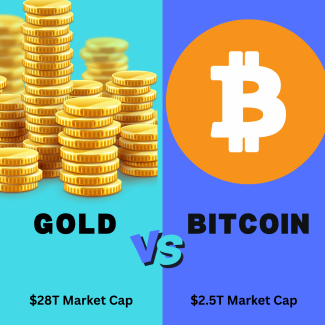
Gold vs Bitcoin in 2025
Gold vs Bitcoin in 2025 — what happened, why gold still matters, and how Bitcoin stacked up
2025 will likely be remembered as the year gold reminded the world why it has held value for thousands of years — and the year Bitcoin began proving it could do the same in digital form.
This October, gold prices broke past $4,100 an ounce, surging more than 55% year-to-date, a stunning move for an asset often described as “boring.” The rally wasn’t about excitement; it was about erosion — the slow, steady debasement of currency value as governments continue to print, spend, and borrow beyond their means.
When the real yield on money collapses, the “hard stuff” rallies. This is the debasement trade in action: when investors move away from cash and toward assets that can’t be printed.
Gold’s 2025 Rally: Boring No More
Gold set numerous new all-time highs through 2025. Gold’s move this year isn’t speculative. It’s structural. Here are the characteristics of gold that make it valuable.
- Scarcity: Global supply grows just 1–2% per year, while central banks continue to accumulate reserves.
- Durability: It doesn’t corrode or degrade — every ounce ever mined still exists.
- Divisibility and fungibility: Gold can be exchanged in almost any amount, anywhere in the world.
- Censorship resistance: Physical gold sits outside the banking system; it isn’t someone else’s liability.
In short, gold is permanence. And in 2025, permanence is outperforming paper.
Bitcoin’s Parallels — and Its Modern Edge
Bitcoin shares many of gold’s characteristics, but it expresses them in digital form:
Characteristic | Gold | Bitcoin |
Scarcity | Limited by nature and extraction | Hard-capped at 21 million coins |
Durability | Physical, but can be diluted / mixed with other metals | Digital and verifiable on a blockchain |
Divisibility | Can be divided into smaller weights | Divisible into 100 million satoshis per Bitcoin and further divisible on layer 2 protocols |
Portability | Bulky, requires physical storage | Instantly transferable worldwide |
Censorship Resistance | Physical ownership outside banks | Self-custody and global peer-to-peer transferability |
Bitcoin doesn’t replace gold — it modernizes it. It gives investors the same scarcity and independence, but at the speed of the internet.
That’s why leading institutions like Morgan Stanley now classify Bitcoin as a real asset and JPMorgan calls it a digital counterpart to gold. The two assets, though different in form, are responding to the same global pressures — deficits, fiscal expansion, and the steady debasement of money itself.
Bitcoin’s 2025 Performance
While gold soared, Bitcoin climbed roughly 24% year-to-date — a more modest gain on paper, but still part of the same story.
Interestingly, Bitcoin’s volatility relative to gold fell below 2.0, a sign of growing maturity and liquidity. That shift has made Bitcoin increasingly attractive to investors who once dismissed it as too unstable.
With Bitcoin’s market cap near $2.5 trillion, compared to gold’s $28 trillion, the gap between the “old store of value” and the “new” is enormous. Even a small rotation of capital from gold into Bitcoin — say 10% of gold’s market — could create exponential upward pressure, given Bitcoin’s fixed supply and limited market depth.
Bottom Line
- Gold dominated 2025, up over 50%, reaffirming its place as the ultimate store of value.
- Bitcoin held its own, gaining roughly 24% despite volatility and structural tests.
- Both assets surged for the same reason: a growing realization that cash — not crypto — is the most crowded trade of all.
In the new era of the debasement trade, the winning strategy isn’t speculation. It’s preservation.

